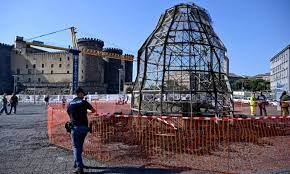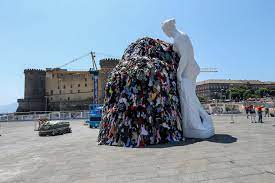Italy: Fire in Naples devours huge artwork by Italian artist; arson suspected

Naples: A fire in Naples has destroyed a large-scale artwork by one of Italy’s most influential living artists, the municipal government said, with the mayor of the ancient city vowing that “vandalism will not stop art.”
The towering open-air installation of “Venus of the Rags” by Michelangelo Pistoletto was inaugurated two weeks ago and depicted the Roman goddess of love behind a mass of tattered cloths. It was on view in the city’s Piazza del Municipio.
The Naples municipality said in a statement on Facebook that the fire occurred at dawn and appeared to be “malicious” in nature, but investigators are still trying to determine the cause. Mayor Gaetano Manfredi told reporters the incident was an “act of great violence” and promised to launch a fundraiser to recreate the work. “When you attack art, you attack man,” he said.
Pistoletto told local media the destruction reflected how society continues to respond to “any offer of beauty, peace and harmony” with “fire and war.”
A contrast between classical beauty and contemporary waste, the sculpture was installed in Naples as a part of a citywide artistic revitalization effort led by the city government and curated by Vincenzo Trione. Pistoletto, who was a prominent figure in Italy’s Arte Povera movement, originally created the work in 1967 and has since made several iterations, which are included in major museum collections such as that of the Hirshhorn Museum and Sculpture Garden in D.C. and the Tate Modern in London.

At a news conference in June, Pistoletto said the “Venus of the Rags” is now “considered an icon of our time,” so in Naples it is “presented at an iconic size.”
Over the years, “Venus of the Rags” has been praised for its increasingly urgent message about sustainability and the visceral way it conveys the perils of waste. At a time when activists are attacking museum artworks in a controversial effort to convey the threat of climate change, Pistoletto’s piece, which literally obscures artistic beauty with man-made garbage, is particularly compelling.
Some were not so pleased by the appearance of the towering Venus and her mountain of trash in their city, however. Online commenters complained about the work on a Facebook post from the mayor that announced its inauguration. One user wrote that the Venus represented “exactly the conditions of Naples, a city reduced to rags,” while another person told local media Venus “ironically” symbolized Naples’s “urban decay.”
Artistically speaking, the garbage is the point. The work is considered emblematic of the Arte Povera, or “poor art,” movement that thrived in the 1960s and ’70s. Embracing banal materials such as rocks, coal and rags as artistic media, Arte Povera artists sought to undermine the elitism and increasing commercialization of the art world. They created juxtapositions of past and present, as seen in Pistoletto’s work, to comment on the effects of modernization.
In art, “all forms, materials, ideas, and means are available and to be used,” Pistoletto said in 1967.
Pistoletto created the first “Venus of the Rags” from rags he used to clean other artworks in his studio. Later, he made a gold-clad version, and in 1980, he turned the piece into a performance artwork, with a live model as the statue.
The fire is another episode in the sculpture’s decades-long evolution. While Manfredi, the mayor, said Pistoletto was angered and hurt by Wednesday’s incident, the artist also told him that it “must be interpreted as a moment of restarting.”





